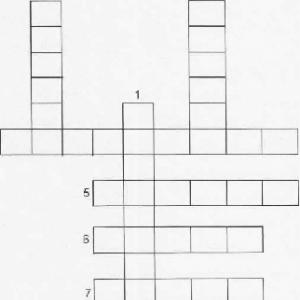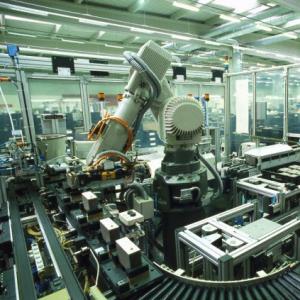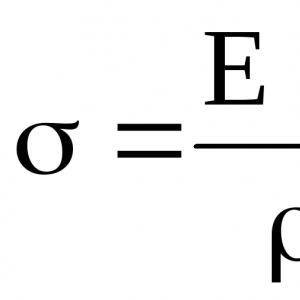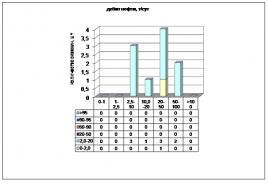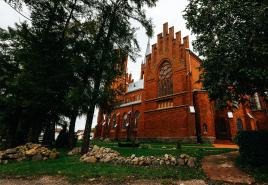What is a metallic bond in chemistry. Metal bond: formation mechanism
A metallic bond is a multicenter bond that exists in metals and their alloys between positively charged ions and valence electrons, which are common to all ions and move freely through the crystal.
They have a small number of valence electrons and low ionization. These electrons, due to the large radii of metal atoms, are rather weakly bound to their nuclei and can easily break away from them and become common to the entire metal crystal. As a result, positively charged metal ions and an electron gas appear in the metal crystal lattice - a set of mobile electrons that freely move around the metal crystal.
As a result, the metal is a series of positive ions localized in certain positions, and a large number of electrons that move relatively freely in the field of positive centers. The spatial structure of metals is a crystal, which can be represented as a cell with positively charged ions at the nodes, immersed in a negatively charged electron gas. All atoms donate their valence electrons to the formation of an electron gas; they move freely inside the crystal without breaking the chemical bond.
The theory of the free movement of electrons in the crystal lattice of metals was experimentally confirmed by the experience of Tolman and Stewart (in 1916): during a sharp deceleration of a previously untwisted coil with a wound wire, free electrons continued to move by inertia for some time, and at this time the ammeter included in the circuit coils, registered the impulse of electric current.
Varieties of metal bond models
Signs of a metallic bond are the following characteristics:
- Multielectronicity, since all valence electrons participate in the formation of a metallic bond;
- Multicenter, or delocalization - a bond connects simultaneously a large number of atoms contained in a metal crystal;
- Isotropy, or non-directionality - due to the unimpeded movement of the electron gas in all directions simultaneously, the metallic bond is spherically symmetrical.
Metal crystals form mainly three types of crystal lattices, however, some metals, depending on temperature, may have different structures.
 Crystal lattices of metals: a) cubic face-centered (Cu, Au, Ag, Al); b) cubic body-centered (Li, Na, Ba, Mo, W, V); c) hexagonal (Mg, Zn, Ti, Cd, Cr)
Crystal lattices of metals: a) cubic face-centered (Cu, Au, Ag, Al); b) cubic body-centered (Li, Na, Ba, Mo, W, V); c) hexagonal (Mg, Zn, Ti, Cd, Cr) A metallic bond exists in crystals and melts of all metals and alloys. In its pure form, it is characteristic of alkali and alkaline earth metals. In transition d-metals, the bond between atoms is partially covalent.
Due to the presence of free electrons (electron gas) and their uniform distribution throughout the crystal, metallic bonding leads to the characteristic general properties of metals and alloys, in particular, high thermal and electrical conductivity, ductility (i.e., the ability to experience deformations without destruction at normal or increased) , opacity and metallic luster due to their ability to reflect light.
Ionic bond
(materials of the website http://www.hemi.nsu.ru/ucheb138.htm were used)
Ionic bonding is carried out by electrostatic attraction between oppositely charged ions. These ions are formed as a result of the transfer of electrons from one atom to another. An ionic bond is formed between atoms that have large differences in electronegativity (usually greater than 1.7 on the Pauling scale), for example, between alkali metals and halogens.
Let us consider the appearance of an ionic bond using the example of the formation of NaCl.
From the electronic formulas of atoms
Na 1s 2 2s 2 2p 6 3s 1 and
Cl 1s 2 2s 2 2p 6 3s 2 3p 5
It can be seen that to complete the external level, it is easier for a sodium atom to give up one electron than to add seven, and it is easier for a chlorine atom to add one than to give up seven. In chemical reactions, the sodium atom donates one electron, and the chlorine atom accepts it. As a result, the electron shells of sodium and chlorine atoms are converted into stable electron shells of noble gases (the electronic configuration of the sodium cation
Na + 1s 2 2s 2 2p 6 ,
and the electronic configuration of the chlorine anion
Cl – - 1s 2 2s 2 2p 6 3s 2 3p 6).
The electrostatic interaction of ions leads to the formation of the NaCl molecule.
The nature of the chemical bond is often reflected in the state of aggregation and the physical properties of the substance. Ionic compounds such as sodium chloride NaCl are solid and refractory because there are powerful forces of electrostatic attraction between the charges of their "+" and "-" ions.
A negatively charged chloride ion attracts not only "its own" Na + ion, but also other sodium ions around it. This leads to the fact that near any of the ions there is not one ion with the opposite sign, but several.
The structure of the sodium chloride NaCl crystal.
In fact, there are 6 sodium ions around each chloride ion, and 6 chloride ions around each sodium ion. Such an ordered packing of ions is called an ionic crystal. If a separate chlorine atom is isolated in a crystal, then among the surrounding sodium atoms it is no longer possible to find the one with which chlorine reacted.
Attracted to each other by electrostatic forces, the ions are extremely reluctant to change their location under the influence of an external force or an increase in temperature. But if sodium chloride is melted and continued to be heated in a vacuum, then it evaporates, forming diatomic NaCl molecules. This suggests that covalent bonding forces are never completely turned off.
The main characteristics of the ionic bond and the properties of ionic compounds
1. An ionic bond is a strong chemical bond. The energy of this bond is about 300 – 700 kJ/mol.
2. Unlike a covalent bond, an ionic bond is non-directional, since an ion can attract ions of the opposite sign to itself in any direction.
3. Unlike a covalent bond, an ionic bond is unsaturated, since the interaction of ions of the opposite sign does not lead to complete mutual compensation of their force fields.
4. In the process of formation of molecules with an ionic bond, there is no complete transfer of electrons, therefore, a 100% ionic bond does not exist in nature. In the NaCl molecule, the chemical bond is only 80% ionic.
5. Ionic compounds are crystalline solids with high melting and boiling points.
6. Most ionic compounds dissolve in water. Solutions and melts of ionic compounds conduct electric current.
metal connection
Metal crystals are arranged differently. If you consider a piece of metallic sodium, you will find that outwardly it is very different from table salt. Sodium is a soft metal, easily cut with a knife, flattened with a hammer, it can be easily melted in a cup on a spirit lamp (melting point 97.8 o C). In a sodium crystal, each atom is surrounded by eight other similar atoms.

The structure of the crystal of metallic Na.
It can be seen from the figure that the Na atom in the center of the cube has 8 nearest neighbors. But the same can be said about any other atom in a crystal, since they are all the same. The crystal consists of "infinitely" repeating fragments shown in this picture.
Metal atoms at the outer energy level contain a small number of valence electrons. Since the ionization energy of metal atoms is low, valence electrons are weakly retained in these atoms. As a result, positively charged ions and free electrons appear in the crystal lattice of metals. In this case, metal cations are located at the nodes of the crystal lattice, and electrons move freely in the field of positive centers, forming the so-called "electron gas".
The presence of a negatively charged electron between two cations leads to the fact that each cation interacts with this electron.
In this way, a metallic bond is a bond between positive ions in metal crystals, which is carried out by the attraction of electrons that move freely throughout the crystal.
Since the valence electrons in the metal are evenly distributed throughout the crystal, the metallic bond, like the ionic one, is an undirected bond. Unlike a covalent bond, a metallic bond is an unsaturated bond. A metallic bond differs from a covalent bond in strength as well. The energy of a metallic bond is about three to four times less than the energy of a covalent bond.
Due to the high mobility of the electron gas, metals are characterized by high electrical and thermal conductivity.
A metal crystal looks simple enough, but its electronic structure is actually more complex than that of ionic salt crystals. There are not enough electrons on the outer electron shell of metal elements to form a full-fledged "octet" covalent or ionic bond. Therefore, in the gaseous state, most metals consist of monatomic molecules (i.e., individual, unrelated atoms). A typical example is mercury vapor. Thus, a metallic bond between metal atoms occurs only in the liquid and solid state of aggregation.
A metallic bond can be described as follows: some of the metal atoms in the resulting crystal give their valence electrons to the space between the atoms (in sodium it is ... 3s1), turning into ions. Since all metal atoms in a crystal are the same, each of them has an equal chance of losing a valence electron.
In other words, the transition of electrons between neutral and ionized metal atoms occurs without energy consumption. In this case, a part of the electrons always ends up in the space between the atoms in the form of an "electron gas".
These free electrons, firstly, hold the metal atoms at a certain equilibrium distance from each other.
Secondly, they give metals a characteristic "metallic sheen" (free electrons can interact with light quanta).
Thirdly, free electrons provide metals with good electrical conductivity. The high thermal conductivity of metals is also explained by the presence of free electrons in the interatomic space - they easily "respond" to changes in energy and contribute to its rapid transfer in the crystal.

A simplified model of the electronic structure of a metal crystal.
******** On the example of sodium metal, let us consider the nature of the metallic bond from the point of view of ideas about atomic orbitals. The sodium atom, like many other metals, has a lack of valence electrons, but there are free valence orbitals. The only 3s electron of sodium is able to move to any of the free and close in energy neighboring orbitals. When atoms in a crystal approach each other, the outer orbitals of neighboring atoms overlap, due to which the donated electrons move freely throughout the crystal.
However, the "electron gas" is not at all disordered, as it might seem. Free electrons in a metal crystal are in overlapping orbitals and are socialized to some extent, forming a kind of covalent bonds. Sodium, potassium, rubidium, and other metallic s-elements simply have few shared electrons, so their crystals are fragile and fusible. With an increase in the number of valence electrons, the strength of metals, as a rule, increases.
Thus, elements tend to form a metallic bond, the atoms of which on the outer shells have few valence electrons. These valence electrons, which carry out the metallic bond, are socialized to such an extent that they can move throughout the entire metal crystal and provide a high electrical conductivity of the metal.
The NaCl crystal does not conduct electricity because there are no free electrons in the space between the ions. All electrons donated by sodium atoms firmly hold chloride ions around them. This is one of the essential differences between ionic crystals and metallic ones.
What you now know about the metallic bond also explains the high malleability (ductility) of most metals. Metal can be flattened into a thin sheet, pulled into a wire. The fact is that individual layers of atoms in a metal crystal can relatively easily slide one over the other: the mobile "electron gas" constantly softens the movement of individual positive ions, shielding them from each other.
Of course, nothing of the kind can be done with table salt, although salt is also a crystalline substance. In ionic crystals, valence electrons are firmly bound to the nucleus of an atom. The shift of one layer of ions relative to another leads to the convergence of ions of the same charge and causes a strong repulsion between them, resulting in the destruction of the crystal (NaCl is a brittle substance).

The shift of the layers of the ionic crystal causes the appearance of large repulsive forces between like ions and the destruction of the crystal.
Navigation
- Solving combined problems based on the quantitative characteristics of a substance
- Problem solving. The law of the constancy of the composition of substances. Calculations using the concepts of "molar mass" and "chemical amount" of a substance
A metallic bond is a bond formed between atoms under conditions of strongly pronounced delocalization (the spread of valence electrons along several chemical bonds in a compound) and a shortage of electrons in an atom (crystal). It is unsaturated and spatially non-directional.
The delocalization of valence electrons in metals is a consequence of the multicenter nature of the metallic bond. The multicenter nature of the metallic bond ensures high electrical and thermal conductivity of metals.
Saturability determined by the number of valence orbitals involved in the formation of chemical. connections. Quantitative characteristic - valence. Valence - the number of bonds that one atom can form with others; - is determined by the number of valence orbitals involved in the formation of bonds by the exchange and donor-acceptor mechanism.
Orientation – the connection is formed in the direction of maximum overlap of electron clouds; - determines the chemical and crystal-chemical structure of a substance (how the atoms are connected in the crystal lattice).
When a covalent bond is formed, the electron density is concentrated between the interacting atoms (drawing from a notebook). In the case of a metallic bond, the electron density is delocalized over the entire crystal. (drawing from a notebook)
(example from notebook)
Due to the unsaturation and non-directional nature of the metallic bond, metallic bodies (crystals) are highly symmetrical and highly coordinated. The overwhelming majority of crystalline structures of a metal correspond to 3 types of atom packing in crystals:
1. HCC– Grenet-centered cubic close-packed structure. Packing density - 74.05%, coordination number = 12.
2. GPU– hexagonal close-packed structure, packing density = 74.05%, c.h. = 12.
3. BCC– volume is centered, packing density = 68.1%, k.ch. = 8.
A metallic bond does not preclude some degree of covalence. Metal bond in its pure form is typical only for alkali and alkaline earth metals.
A pure metallic bond is characterized by an energy of the order of 100/150/200 kJ/mol, which is 4 times weaker than the covalent one.
36. Chlorine and its properties. B \u003d 1 (III, IV, V and VII) oxidation state \u003d 7, 6, 5, 4, 3, 1, −1
greenish-yellow gas with a pungent, irritating odor. Chlorine occurs in nature only in the form of compounds. In nature, in the form of potassium chloride, magnesium, nitrium, formed as a result of the evaporation of former seas and lakes. Receipt.prom: 2NaCl + 2H2O \u003d 2NaOH + H2 + Cl2, by electrolysis of waters of chlorides Me.\2KMnO4 + 16HCl \u003d 2MnCl2 + 2KCl + 8H2O + 5Cl2 / Chemically, chlorine is very active, directly combines with almost all Me, and with non-metals (except carbon, nitrogen, oxygen, inert gases), replaces hydrogen in the pre-HC and joins unsaturated compounds, displaces bromine and iodine from their compounds. Phosphorus ignites in an atmosphere of chlorine PCl3, and with further chlorination - PCl5; sulfur with chlorine = S2Cl2, SCl2 and other SnClm. A mixture of chlorine and hydrogen burns. With oxygen, chlorine forms oxides: Cl2O, ClO2, Cl2O6, Cl2O7, Cl2O8, as well as hypochlorites (salts of hypochlorous acid), chlorites, chlorates and perchlorates. All oxygen compounds of chlorine form explosive mixtures with easily oxidized substances. Chlorine oxides are unstable and can explode spontaneously, hypochlorites decompose slowly during storage, chlorates and perchlorates can explode under the influence of initiators. in water - hypochlorous and salt: Сl2 + Н2О = НClО + НCl. When chlorinating aqueous solutions of alkalis in the cold, hypochlorites and chlorides are formed: 2NaOH + Cl2 \u003d NaClO + NaCl + H2O, and when heated - chlorates. When ammonia reacts with chlorine, nitrogen trichloride is formed. with other halogens interhalogen compounds. Fluorides СlF, СlF3, СlF5 are very reactive; for example, in a ClF3 atmosphere, glass wool ignites spontaneously. Known compounds of chlorine with oxygen to fluorine are chlorine oxyfluorides: ClO3F, ClO2F3, ClOF, ClOF3 and fluorine perchlorate FClO4. Application: production of chemical compounds, water purification, synthesis in food, farm prom-ti-bactericide, antiseptic, whitening of papers, fabrics, pyrotechnics, matches, destroys weeds in CX.
Biological role: biogenic component of plant and animal tissues. 100g the main osmotically active substance of blood plasma, lymph, cerebrospinal fluid and some tissues. Sodium chloride daily requirement = 6-9g-bread, meat and dairy products. Plays a role in water-salt metabolism, contributing to the retention of water by tissues. The regulation of acid-base balance in tissues is carried out along with other processes by changing the distribution of chlorine between the blood and other tissues, chlorine is involved in energy metabolism in plants, activating both oxidative phosphorylation and photophosphorylation. Chlorine has a positive effect on the absorption of oxygen by the roots, a component of the iron juice.
37. Hydrogen, water. B \u003d 1; st.oxide \u003d + 1-1 The hydrogen ion is completely devoid of electron shells; it can approach very close distances and be introduced into electron shells.
The most common element in the universe. It makes up the bulk of the Sun, stars and other cosmic bodies. It is relatively rare in the free state on Earth - it is found in petroleum and combustible gases, is present as inclusions in some minerals, and most of it is in the composition of water. Receipt: 1. Laboratory Zn+2HCl=ZnCl2+H 2 ; 2.Si + 2NaOH + H 2 O \u003d Na 2 SiO 3 + 2H 2; 3. Al + NaOH + H 2 O \u003d Na (AlOH) 4 + H 2. 4. In industry: conversion, electrolysis: СH4+H2O=CO+3H2\CO+H2O=CO+ H2/Chemistry. N.O.: H 2 + F 2 \u003d 2HF. When irradiated, illuminated, catalysts: H 2 + O 2, S, N, P \u003d H 2 O, H 2 S, NH 3, Ca + H2 \u003d CaH2 \ F2 + H2 \u003d 2HF \ N2 + 3H2 → 2NH3 \ Cl2 + H2 → 2HCl, 2NO+2H2=N2+2H2O,CuO+H2=Cu+H2O,CO+H2=CH3OH. Hydrogen forms hydrides: ionic, covalent and metallic. To ionic -NaH - &, CaH 2 - & + H 2 O \u003d Ca (OH) 2; NaH + H 2 O \u003d NaOH + H 2. Covalent -B 2 H 6, AlH 3, SiH 4. Metal - with d-elements; variable composition: MeH ≤1 , MeH ≤2 - are introduced into the voids between atoms. Conducts heat, current, solid. WATER.sp3-hybrid highly polar.molecule at an angle of 104.5 , dipoles, the most common solvent. Water reacts at room t: with active halogens (F, Cl) and interhaloid compounds with salts, forming a weak acid and a weak base, causing their complete hydrolysis ; with anhydrides and carboxylic and inorganic acid halides. kis-t; with active metalorgan-mi compounds; with carbides, nitrides, phosphides, silicides, active Me hydrides; with many salts, forming hydrates; with boranes, silanes; with ketenes, carbon suboxide; with noble gas fluorides. Water reacts when heated: with Fe, Mg with coal, methane; with some alkyl halides. Application:hydrogen - synthesis of ammonia, methanol, hydrogen chloride, TV fats, hydrogen flame - for welding, melting, in metallurgy for the reduction of Me from oxide, rocket fuel, in pharmacy - water, peroxide antiseptic, bactericide, washing, hair bleaching, sterilization.
Biol.role: hydrogen-7kg, The main function of hydrogen is the structuring of biological space (water and hydrogen bonds) and the formation of a variety of org molecules (included in the structure of proteins, carbohydrates, fats, enzymes) Thanks to hydrogen bonds,
copying of the DNA molecule. Water takes part in a huge
the number of biochemical reactions, in all physiological and biological
processes, ensures the exchange of substances between the body and the environment, between
cells and within cells. Water is the structural basis of cells, necessary for
maintaining their optimal volume, it determines the spatial structure and
functions of biomolecules.
A metallic bond occurs between metal atoms. A characteristic feature of metal atoms is a small number of electrons in the outer energy level, weakly held by the nucleus, and a large number of free atomic orbitals with similar energies, so the metallic bond is unsaturated.
Valence electrons participate in the formation of bonds with 8 or 12 atoms at once (according to the coordination number of metal atoms). Under these conditions, valence electrons with a low ionization energy move along the available orbitals of all neighboring atoms, providing a connection between them.
metal connection characterized by a weak interaction of common electrons with the nuclei of the connected atoms and the complete delocalization of these electrons between all atoms in the crystal, which ensures the stability of this bond.
Scheme of the formation of a metallic bond (M - metal):
M 0 - ne M n +
Metals have a special crystal lattice, in the nodes of which there are both neutral and positively charged metal atoms, between which socialized electrons ("electron gas") move freely (within the crystal). The movement of common electrons in metals is carried out along a set of molecular orbitals that have arisen due to the merger of a large number of free orbitals of the connected atoms and covering many atomic nuclei. In the case of a metallic bond, it is impossible to talk about its directionality, since the common electrons are uniformly delocalized throughout the crystal.
The structural features of metals determine their characteristic physical properties: hardness, ductility, high electrical and thermal conductivity, as well as a special metallic luster.
The metallic bond is characteristic of metals not only in the solid state, but also in the liquid state, that is, this is a property of aggregates of atoms located in close proximity to each other. In the gaseous state, metal atoms are interconnected by one or more covalent bonds into molecules, for example, Li 2 (Li–Li), Be 2 (Be = Be), Al 4 - each aluminum atom is connected to three others to form a tetrahedral structure:
4. Hydrogen bond
A hydrogen bond is a special type of bond that is unique to hydrogen atoms. It occurs when a hydrogen atom is bonded to an atom of the most electronegative elements, primarily fluorine, oxygen, and nitrogen. Consider the formation of a hydrogen bond on the example of hydrogen fluoride. The electronegative hydrogen atom has only one electron, thanks to which it can form a covalent bond with the fluorine atom. In this case, a hydrogen fluoride molecule H-F arises, in which the common electron pair is shifted to the fluorine atom.
As a result of this electron density distribution, the hydrogen fluoride molecule is a dipole, the positive pole of which is a hydrogen atom. Due to the fact that the binding electron pair is shifted to the fluorine atom, it is partially released 1 s-orbital of the hydrogen atom and its nucleus is partially exposed. In any other atom, the positive charge of the nucleus after the removal of valence electrons is shielded by internal electron shells, which provide repulsion of the electron shells of other atoms. The hydrogen atom does not have such shells, its nucleus is a very small (subatomic) positively charged particle - a proton (the diameter of a proton is about 10 5 times smaller than the diameters of atoms, and, due to the absence of electrons in it, it is attracted by the electron shell of other electrically neutral or negatively charged atoms).
The strength of the electric field near the partially "naked" hydrogen atom is so great that it can actively attract the negative pole of the neighboring molecule. Since this pole is the fluorine atom, which has three nonbonding electron pairs, and s- the orbital of the hydrogen atom is partially vacant, then a donor-acceptor interaction occurs between the positively polarized hydrogen atom of one molecule and the negatively polarized fluorine atom of the neighboring molecule.
Thus, as a result of the joint electrostatic and donor-acceptor interaction, an additional second bond arises with the participation of a hydrogen atom. That's what it is hydrogen bond, …H–F H–F…
It differs from covalent in energy and length. Hydrogen bonds are longer and less strong than covalent bonds. The energy of a hydrogen bond is 8–40 kJ/mol, and that of a covalent bond is 80–400 kJ/mol. In solid hydrogen fluoride, the length of the covalent bond H–F is 95 pm, the length of the hydrogen bond FH is 156 pm. Due to hydrogen bonding between HF molecules, solid hydrogen fluoride crystals consist of endless flat zigzag chains, since the three-atom system formed by hydrogen bonding is usually linear.
Hydrogen bonds between HF molecules are partially preserved in liquid and even in gaseous hydrogen fluoride.
The hydrogen bond is conditionally written as three points and is depicted as follows:
where X, Y are F, O, N, Cl, S atoms.
The energy and length of a hydrogen bond are determined by the dipole moment of the H–X bond and the size of the Y atom. The length of the hydrogen bond decreases, and its energy increases with an increase in the difference between the electronegativities of the X and Y atoms (and, accordingly, the dipole moment of the H–X bond) and with a decrease in the size of the Y atom .

Hydrogen bonds are also formed between molecules in which there are O–H bonds (for example, water H 2 O, perchloric acid HClO 4, nitric acid HNO 3, carboxylic acids RCOOH, phenol C 6 H 5 OH, ROH alcohols) and N–H (eg ammonia NH 3 , thiocyanic acid HNCS, organic amides RCONH 2 and amines RNH 2 and R 2 NH).
Substances whose molecules are connected by hydrogen bonds differ in their properties from substances similar to them in the structure of molecules, but which do not form hydrogen bonds. The melting and boiling points of hydrides of group IVA elements, in which there are no hydrogen bonds, gradually decrease with decreasing period number (Fig. 15). Hydrides of elements of groups VA-VIIA exhibit a violation of this dependence. Three substances whose molecules are connected by hydrogen bonds (ammonia NH 3 , water H 2 O and hydrogen fluoride HF) have much higher melting and boiling points than their counterparts (Fig. 15). In addition, these substances have wider temperature ranges of existence in the liquid state, higher heats of fusion and evaporation.
The hydrogen bond plays an important role in the processes of dissolution and crystallization of substances, as well as in the formation of crystalline hydrates.
Hydrogen bonds can form not only between molecules (intermolecular hydrogen bond, MVS) , as is the case in the examples discussed above, but also between atoms of the same molecule (intramolecular hydrogen bond, VVS) . For example, due to intramolecular hydrogen bonds between the hydrogen atoms of the amino groups and the oxygen atoms of the carbonyl groups, the polypeptide chains that form protein molecules have a helical shape.
picture??????????????
Hydrogen bonds play a huge role in the processes of reduplication and biosynthesis of proteins. The two strands of the DNA (deoxyribonucleic acid) double helix are held together by hydrogen bonds. In the process of reduplication, these bonds are broken. During transcription, the synthesis of RNA (ribonucleic acid) using DNA as a template also occurs due to the occurrence of hydrogen bonds. Both processes are possible because hydrogen bonds are easily formed and easily broken.

Rice. 15. Melting points ( a) and boiling ( b) hydrides of elements of groups IVА-VIIA.
Metal connection. Properties of a metallic bond.
A metallic bond is a chemical bond due to the presence of relatively free electrons. It is characteristic both for pure metals and their alloys and intermetallic compounds.
Metal bond mechanism
Positive metal ions are located at all nodes of the crystal lattice. Between them randomly, like gas molecules, valence electrons move, unhooked from atoms during the formation of ions. These electrons play the role of cement, holding the positive ions together; otherwise, the lattice would disintegrate under the action of repulsive forces between the ions. At the same time, electrons are also held by ions within the crystal lattice and cannot leave it. Communication forces are not localized and not directed. For this reason, high coordination numbers (eg 12 or 8) appear in most cases. When two metal atoms approach each other, their outer shell orbitals overlap to form molecular orbitals. If a third atom comes up, its orbital overlaps with the orbitals of the first two atoms, giving one more molecular orbital. When there are many atoms, a huge number of three-dimensional molecular orbitals arise, extending in all directions. Due to the multiple overlapping of orbitals, the valence electrons of each atom are influenced by many atoms.
Characteristic crystal lattices
Most metals form one of the following highly symmetric close-packed lattices: body-centered cubic, face-centered cubic, and hexagonal.
In a cubic body-centered lattice (bcc), the atoms are located at the vertices of the cube and one atom is located at the center of the volume of the cube. Metals have a cubic body-centered lattice: Pb, K, Na, Li, β-Ti, β-Zr, Ta, W, V, α-Fe, Cr, Nb, Ba, etc.
In a face-centered cubic lattice (fcc), atoms are located at the vertices of the cube and at the center of each face. Metals of this type have a lattice: α-Ca, Ce, α-Sr, Pb, Ni, Ag, Au, Pd, Pt, Rh, γ-Fe, Cu, α-Co, etc.
In a hexagonal lattice, atoms are located at the vertices and the center of the hexagonal bases of the prism, and three atoms are located in the middle plane of the prism. Metals have such a packing of atoms: Mg, α-Ti, Cd, Re, Os, Ru, Zn, β-Co, Be, β-Ca, etc.
Other properties
Freely moving electrons cause high electrical and thermal conductivity. Substances with a metallic bond often combine strength with ductility, since when atoms are displaced relative to each other, bonds do not break. Another important property is metallic aromaticity.
Metals conduct heat and electricity well, they are strong enough, they can be deformed without breaking. Some metals are malleable (they can be forged), some are malleable (they can be drawn into wire). These unique properties are explained by a special type of chemical bond that connects metal atoms to each other - a metallic bond.
Metals in the solid state exist in the form of crystals of positive ions, as if “floating” in a sea of electrons freely moving between them.
The metallic bond explains the properties of metals, in particular their strength. Under the action of a deforming force, the metal lattice can change its shape without cracking, unlike ionic crystals.
The high thermal conductivity of metals is explained by the fact that if you heat a piece of metal on one side, then the kinetic energy of electrons will increase. This increase in energy will propagate in the "electronic sea" throughout the sample at great speed.
The electrical conductivity of metals also becomes clear. If a potential difference is applied to the ends of a metal sample, then the cloud of delocalized electrons will shift in the direction of the positive potential: this flow of electrons moving in the same direction is the familiar electric current.
Metal connection. Properties of a metallic bond. - concept and types. Classification and features of the category "Metal bond. Metal bond properties." 2017, 2018.

